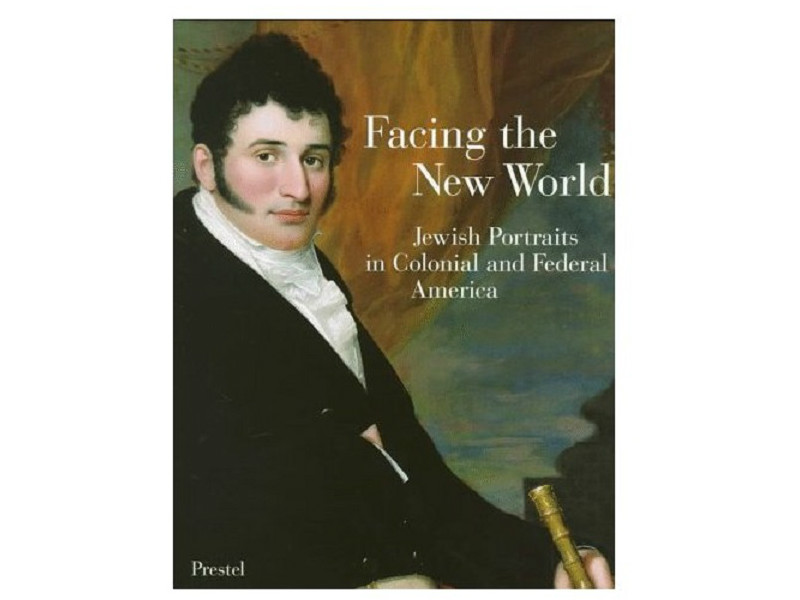A few weeks ago, apropos of nothing, I went to one of my bookshelves and plucked out something I’ve been meaning to read for a while.
In a section devoted to art books, one unusual title has been lurking in the midst: Richard Brilliant’s Facing the New World: Jewish Portraits in Colonial and Federal America (1997).
My wife and I gave this book to my grandparents, Max and Rhona Alexandroff, on the occasion of their 60th wedding anniversary in 1998. It was added to my collection when my grandfather died in 2003. (My grandmother followed him five years later.)
READ: POLISH AUTHOR OPENS UP ABOUT HER HIDDEN JEWISH PAST
I’ve glanced at it several times, even read a few pages here and there. But I’ve never sat down and analyzed it until now.
Brilliant is the Anna S. Garbedian professor emeritus in the humanities at Columbia University’s department of art history and archeology. His book was published in conjunction with an exhibit of the same name at the Jewish Museum in New York from September 1997 to January 1998, followed by one at the Maryland Historical Society in Baltimore from February to May 1998.
Then-Jewish Museum director Joan Rosenblum wrote in the book’s introduction that it covered a “little-known but fascinating chapter of American Jewish life, culture and history.” The artistic subjects were “typically leading members of their communities – men of affairs and women of good families.” Prominent American artists, including Thomas Sully, John Wesley Jarvis and Gilbert Stuart, were commissioned to create these portraits.
Here’s some perspective. America’s Jewish population grew from about 1,300 to 1,500 in 1790 (when the first census was taken) to an estimated 4,000 in 1830. This comes out to roughly 0.03 or 0.04 per cent of the total U.S. population. In other words, the community was exceedingly small.
While some American Jews lived in poverty, a fair number were linked to mercantilism. This included Moses Raphael Levy, who owned ships, dabbled in real estate and conducted business both at home and abroad, and his eventual son-in-law, Jacob Franks, a businessman with shipping, wholesale and retail operations, domestically and internationally.
Hence, certain families had the ability – and disposable income – to hire portrait artists, a common practice among well-to-do Christians. Besides the New York-based Levy-Franks paintings, the book examines the artistic renderings of other families, including Etting (Baltimore), Myers (Norfolk, Va.), Israel (Wilmington, Del.) and Touro (Newport, R.I.).
There are some intriguing aspects in these portraits. Brilliant noted that Jewish portraiture in colonial and federal America “remained tied to an 18th-century bourgeois imagery of restrained sobriety, thereby maintaining the effective distancing of its subjects from the viewer.” Most of these traditional paintings fit into the artistic movement of romanticism, although an underlying neoclassical theme is prevalent. A few portraits included objects (a chair, table, book or watch) that one would expect from this time period.
Anti-Semitism obviously existed in 19th-century America. Even in the cities, towns and villages where Jews had resided for decades, they were often seen as outsiders. Yet, there was “no overt attempt… to suggest the Jewishness of the subjects, either by including some elements of an allegedly distinguishing physiognomy – ‘Jewish looks’ – or by an identifying attribute, drawn from the world of ceremonial objects, usually found in Jewish homes but not in these portraits.”
READ: A SNAPSHOT OF A LOST PREWAR POLISH JEWISH COMMUNITY
While their personal/religious lineage was important to them, their commitment and patriotism to America trumped all else.
“The very existence of these Jewish portraits,” Brilliant wrote, “bears witness to the importance placed upon the deliberate confection of their faces and their fashionably clothed bodies as conventionally, and recognizably, ‘American.’” Moreover, these portraits could be interpreted “as emissaries to a world indifferent or hostile to attempts to proclaim ethnic distinction.”
There’s much to be said about the great American melting pot. This thought-provoking book is proof that U.S. Jews used to take it seriously – and many still do.
